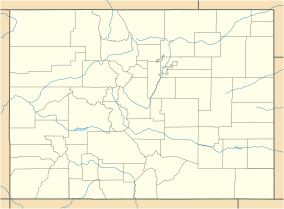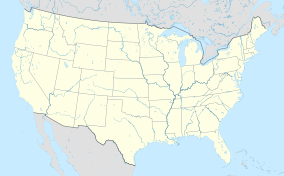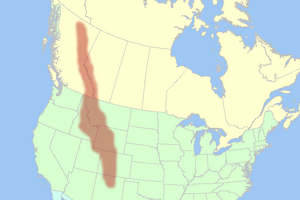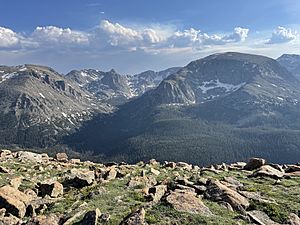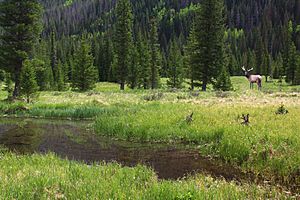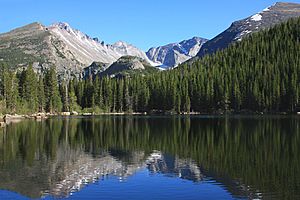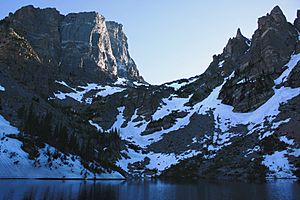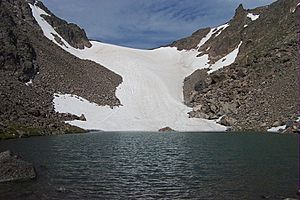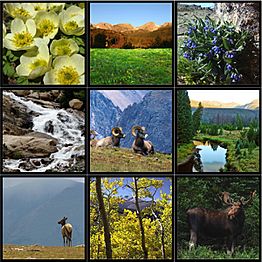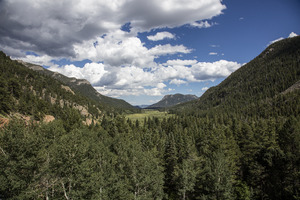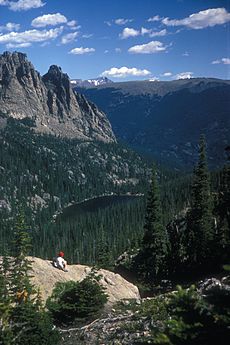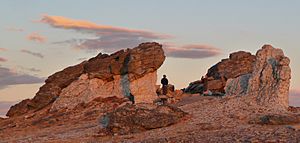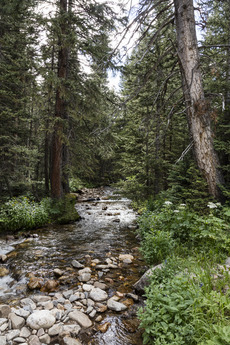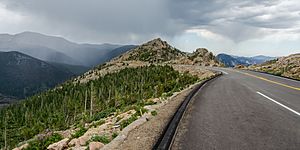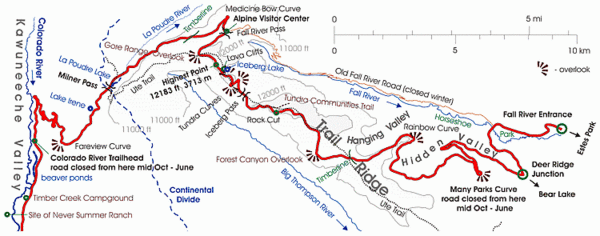Rocky Mountain National Park facts for kids
Quick facts for kids Rocky Mountain National Park |
|
|---|---|
|
IUCN Category II (National Park)
|
|
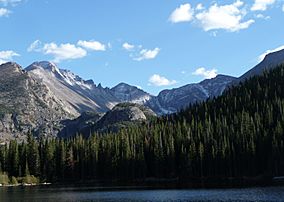
View from Bear Lake in Rocky Mountain National Park
|
|
| Location | Larimer / Grand / Boulder counties, Colorado, United States |
| Nearest city | Estes Park and Grand Lake, Colorado |
| Area | 265,461 acres (1,074.28 km2) |
| Established | January 26, 1915 |
| Visitors | 4,300,424 (in 2022) |
| Governing body | National Park Service |
| Website | Rocky Mountain National Park |
Rocky Mountain National Park is a beautiful national park in north-central Colorado, USA. It's about 55 miles (88 km) northwest of Denver. The park sits between the towns of Estes Park on the east and Grand Lake on the west.
The Continental Divide runs right through the middle of the park. This means rivers on one side flow to the Pacific Ocean, and rivers on the other side flow to the Atlantic. The Colorado River even starts here! The park is famous for its tall mountains, clear alpine lakes, and many different kinds of wildlife. You can find everything from thick forests to cold mountain tundra.
President Woodrow Wilson created Rocky Mountain National Park on January 26, 1915. This protected the land for everyone to enjoy. In the 1930s, the Civilian Conservation Corps built Trail Ridge Road, a famous scenic drive. In 1976, UNESCO named the park a World Biosphere Reserve. This means it's a special place for nature and learning. Millions of people visit the park every year, making it one of the most popular national parks.
The park has five visitor centers. The main one, Beaver Meadows Visitor Center, is a National Historic Landmark. It was designed by the famous architect Frank Lloyd Wright's school. Other National Forests surround the park, like Roosevelt National Forest and Arapaho National Forest.
Contents
Park History: How It Began
Long ago, Paleo-Indians traveled through this area to hunt and find food. Later, Ute and Arapaho people hunted and camped here. In 1820, an exploration team led by Stephen H. Long explored the Rockies. Longs Peak is named after him.
Settlers started arriving in the mid-1800s. Many Native Americans left the area by 1860. Some were later moved to reservations.
In the 1870s, people came looking for gold and silver. Towns like Lulu City and Dutchtown were built. But the mining boom ended by 1883, and the miners left.
The railroad reached Lyons, Colorado in 1881. A road through the Big Thompson Canyon was finished in 1904. The 1920s brought more lodges and roads to the park. The famous Trail Ridge Road was built between 1929 and 1938.
Important people like Enos Mills worked hard to make this area a national park. Their efforts led to the park being created on January 26, 1915.
Park Geography: Mountains, Rivers, and Lakes
Rocky Mountain National Park covers about 265,461 acres (1,074 km²). More wilderness land from the U.S. Forest Service is next to the park. The Continental Divide runs north-south through the park's center. Rivers on the west side flow to the Pacific Ocean. Rivers on the east side flow to the Atlantic Ocean.
There's a cool spot in the Never Summer Mountains where the Continental Divide makes a horseshoe shape. This causes streams on the eastern slopes to flow to the Colorado River (which goes to the Pacific). But streams on the western slopes flow to rivers that eventually reach the Atlantic!
The Colorado River starts in the park's northwest. The park has about 450 miles (724 km) of rivers and streams. It also has 350 miles (563 km) of trails and 150 lakes.
Rocky Mountain National Park is one of the highest national parks. Its elevations range from 7,860 feet (2,396 m) to 14,259 feet (4,346 m). The highest point is Longs Peak. Trail Ridge Road is the highest paved road in the country, reaching 12,183 feet (3,713 m). There are sixty mountain peaks over 12,000 feet (3,658 m) high. The Mummy Range in the north has several peaks over 13,000 feet (3,962 m). You can also find small glaciers and permanent snowfields in the high mountains.
The park has five main areas, or geographical zones:
Moose and Big Meadows Area
This area is on the west side of the Continental Divide, near Grand Lake. It's known for its moose and large meadows. About 30 miles (48 km) of the Continental Divide National Scenic Trail goes through this part of the park. It passes through alpine tundra and beautiful scenery.
The Big Meadows area has many grasses and wildflowers. You can reach it by trails like Onahu, Tonahutu, or Green Mountain. Other scenic spots include Long Meadows and the Kawuneeche Valley. This valley is a great place for birdwatching. In winter, it's good for snowshoeing and cross-country skiing.
LuLu City was an old silver mining town from the 1880s. Today, you can still see a few cabin ruins there.
Alpine Tundra Region
This is the high-elevation area of the park, known for its amazing views. You can find tundra trails here. Mount Ida is in this region, offering wide-open views of the Continental Divide.
The Tundra Communities Trail, off Trail Ridge Road, is a great hike to see tundra plants and alpine wildflowers. Other trails include Tombstone Ridge and the Ute Trail. Lake Irene is a nice spot for picnics.
Wilderness Escape Region
Region 3 is in the northern part of the park, accessed from Estes Park. It's known for its wild, untouched areas.
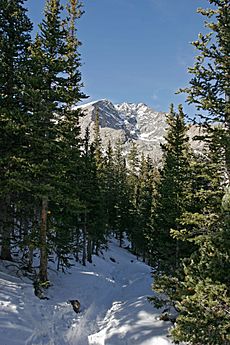
The Mummy Range is a mountain range here. These mountains are often gentler and more forested than others in the park. But some parts are rugged and have glaciers, especially around Ypsilon Mountain.
You can find beautiful waterfalls like Bridal Veil Falls, West Creek Falls, and Chasm Falls. The Alluvial Fan trail leads to a bridge over a river. This was the site of the Lawn Lake Flood in 1982.
The Lumpy Ridge Trail leads to cool rock formations like Paul Bunyan's Boot and Balanced Rock. The Deer Mountain Trail gives you a 360-degree view of the eastern part of the park. In winter, you might need snowshoes or skis for this trail.
The trail to Lake Estes is great for birdwatchers, bikers, and hikers. It goes along the Big Thompson River. The Lawn Lake Trail climbs to Lawn Lake and Crystal Lake. This trail also shows the damage from the 1982 dam failure.
Heart of the Park: Popular Trails and Lakes
This area is easy to reach by road and has many popular trails and lakes. Flattop Mountain offers an easy hike to the Continental Divide. The hike to Hallett Peak crosses three climate zones.
Bear Lake is a beautiful lake surrounded by spruce and fir trees. Bierstadt Lake sits on top of a lateral moraine (a ridge formed by a glacier). You can hike to it through aspen and pine trees. Hollowell Park is a large, marshy meadow nearby.
Glacial Basin was once a resort. Sprague Lake is named after the people who ran it. They created the lake by damming Boulder Brook. It's a popular spot for birdwatching and camping.
Dream Lake and Emerald Lake are very popular for photos and winter snowshoeing. Lake Haiyaha means "big rocks" in a Native American language. Its shore is covered with boulders and old pine trees. Nymph Lake is named for the yellow lilies on its surface.
The Cub Lake trail passes the Big Thompson River and flowery meadows. In winter, you need skis or snowshoes. The Fern Lake trail goes past Arch Rock and Fern Falls. Odessa Lake can be reached from either the Flattop trail or the Fern Lake trailhead.
Other beautiful lakes include Jewel Lake, Mills Lake, Black Lake, and Sky Pond. The Pool is where Spruce and Fern Creeks join the Big Thompson River. The trail to Alberta Falls runs by Glacier Creek.
Waterfalls and Backcountry Region
Region 5 is south of Estes Park. It's known for its waterfalls and wild backcountry. This area includes Longs Peak, the park's tallest mountain. Other peaks are Lily Mountain and Estes Cone.
Enos Mills, who helped create the park, loved walking to Lily Lake. Wildflowers bloom here in spring and early summer. In winter, the trail around the lake is good for walking or snowshoeing.
Other lakes in the Wild Basin area include Chasm Lake, Thunder Lake, and Ouzel Lake. Many of these lakes have campsites for backpackers. Waterfalls include Ouzel Falls, Trio Falls, Copeland Falls, and Calypso Cascades.
Park Climate: Weather in the Mountains
The park has a Subarctic climate, meaning cool summers and precipitation all year. The weather here can be extreme. Cold air from the north often meets warm, moist air from the Gulf of Mexico. This causes heavy, wet snowfalls in the park.
| Climate data for Bear Lake Ranger Station, Rocky Mountain National Park. Elev: 9583 ft (2921 m) | |||||||||||||
|---|---|---|---|---|---|---|---|---|---|---|---|---|---|
| Month | Jan | Feb | Mar | Apr | May | Jun | Jul | Aug | Sep | Oct | Nov | Dec | Year |
| Mean daily maximum °F (°C) | 28.6 (−1.9) |
30.8 (−0.7) |
37.5 (3.1) |
44.1 (6.7) |
53.2 (11.8) |
63.7 (17.6) |
70.7 (21.5) |
68.6 (20.3) |
60.7 (15.9) |
49.2 (9.6) |
36.0 (2.2) |
28.3 (−2.1) |
47.7 (8.7) |
| Daily mean °F (°C) | 20.1 (−6.6) |
21.2 (−6.0) |
26.9 (−2.8) |
33.0 (0.6) |
41.5 (5.3) |
50.5 (10.3) |
56.9 (13.8) |
55.4 (13.0) |
48.2 (9.0) |
38.6 (3.7) |
27.4 (−2.6) |
20.0 (−6.7) |
36.7 (2.6) |
| Mean daily minimum °F (°C) | 11.6 (−11.3) |
11.7 (−11.3) |
16.2 (−8.8) |
21.8 (−5.7) |
29.7 (−1.3) |
37.2 (2.9) |
43.0 (6.1) |
42.1 (5.6) |
35.6 (2.0) |
28.0 (−2.2) |
18.9 (−7.3) |
11.6 (−11.3) |
25.7 (−3.5) |
| Average precipitation inches (mm) | 2.72 (69) |
2.97 (75) |
3.83 (97) |
4.34 (110) |
3.39 (86) |
2.11 (54) |
2.21 (56) |
2.20 (56) |
2.10 (53) |
2.39 (61) |
3.04 (77) |
3.11 (79) |
34.41 (874) |
| Average relative humidity (%) | 56.5 | 56.4 | 54.3 | 54.3 | 55.2 | 50.1 | 48.6 | 54.2 | 50.0 | 47.2 | 52.5 | 57.3 | 53.0 |
| Average dew point °F (°C) | 7.1 (−13.8) |
8.1 (−13.3) |
12.6 (−10.8) |
18.3 (−7.6) |
26.6 (−3.0) |
32.6 (0.3) |
37.7 (3.2) |
39.1 (3.9) |
30.4 (−0.9) |
20.2 (−6.6) |
12.3 (−10.9) |
7.3 (−13.7) |
21.1 (−6.1) |
| Source: PRISM Climate Group | |||||||||||||
| Climate data for Beaver Meadows Visitor Center, Rocky Mountain National Park. Elev: 7877 ft (2401 m) | |||||||||||||
|---|---|---|---|---|---|---|---|---|---|---|---|---|---|
| Month | Jan | Feb | Mar | Apr | May | Jun | Jul | Aug | Sep | Oct | Nov | Dec | Year |
| Mean daily maximum °F (°C) | 36.4 (2.4) |
38.4 (3.6) |
44.2 (6.8) |
50.7 (10.4) |
60.1 (15.6) |
71.2 (21.8) |
78.1 (25.6) |
76.1 (24.5) |
68.1 (20.1) |
56.7 (13.7) |
43.5 (6.4) |
35.9 (2.2) |
55.0 (12.8) |
| Daily mean °F (°C) | 25.8 (−3.4) |
26.9 (−2.8) |
32.4 (0.2) |
38.4 (3.6) |
47.0 (8.3) |
56.1 (13.4) |
62.4 (16.9) |
60.6 (15.9) |
53.0 (11.7) |
43.5 (6.4) |
33.0 (0.6) |
25.7 (−3.5) |
42.1 (5.6) |
| Mean daily minimum °F (°C) | 15.1 (−9.4) |
15.5 (−9.2) |
20.6 (−6.3) |
26.1 (−3.3) |
34.0 (1.1) |
40.9 (4.9) |
46.6 (8.1) |
45.1 (7.3) |
37.9 (3.3) |
30.3 (−0.9) |
22.6 (−5.2) |
15.6 (−9.1) |
29.3 (−1.5) |
| Average precipitation inches (mm) | 0.76 (19) |
0.81 (21) |
1.94 (49) |
2.36 (60) |
2.48 (63) |
1.99 (51) |
2.39 (61) |
2.02 (51) |
1.46 (37) |
1.04 (26) |
0.87 (22) |
0.83 (21) |
18.95 (481) |
| Average relative humidity (%) | 46.3 | 46.9 | 48.0 | 47.8 | 50.6 | 45.3 | 45.6 | 49.7 | 46.1 | 42.9 | 44.5 | 47.8 | 46.8 |
| Average dew point °F (°C) | 8.0 (−13.3) |
9.3 (−12.6) |
14.9 (−9.5) |
20.3 (−6.5) |
29.6 (−1.3) |
35.2 (1.8) |
41.1 (5.1) |
41.7 (5.4) |
32.8 (0.4) |
22.4 (−5.3) |
13.7 (−10.2) |
8.6 (−13.0) |
23.2 (−4.9) |
| Source: PRISM Climate Group | |||||||||||||
Elevation and Seasons
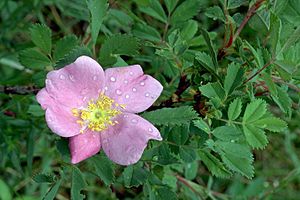
Higher parts of the park get twice as much snow as lower areas. Winters in the high country are very cold, with blizzards and strong winds. If you camp there in winter, you need very warm gear.
Spring arrives in the subalpine region (9,000 to 11,000 feet) around June. Wildflowers bloom from late June to early August.
Below 9,400 feet (2,865 m), temperatures are milder. Spring comes by early May, and wildflowers start blooming. Summer days in July and August are usually warm (70s-80s °F), but nights are cool (40s °F). Afternoon thunderstorms are common in summer. They can cause temperatures to drop quickly.
Continental Divide's Effect on Climate
The Continental Divide splits the park's climate into two different patterns. The east side, near Estes Park, is drier. The west side, near Grand Lake, is wetter with more lush forests. The west side also gets more snow and has clearer, colder winter days.
Climate Change Study
Rocky Mountain National Park is part of a climate change study. Scientists are looking at how changes in weather affect the park's plants and animals.
Over the last 100 years, the park's average temperature has gone up by about 3°F (1.7°C). This means snow melts earlier, leading to drier summers. This also causes a longer wildfire season. Since the 1990s, mountain pine beetles have increased. They are killing more trees because winters are not cold enough to kill them off.
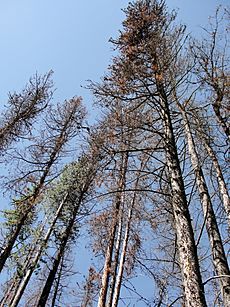
Scientists predict temperatures will keep rising. They also expect less snowfall and more intense rainstorms. Droughts might become more common.
Park Geology: How the Mountains Formed
The rocks in Rocky Mountain National Park tell a long story. Very old metamorphic rocks formed the core of North America billions of years ago. Later, the area was covered by a shallow sea. This sea left behind thick layers of limestone.
About 300 million years ago, the land rose up to create the ancient Rocky Mountains. Over millions of years, wind, rain, snow, and glacial ice wore down these mountains. Eventually, they were buried under new layers of sediment.
About 70 million years ago, the region was again covered by a deep sea. This sea left huge amounts of shale rock and marine life fossils. You can find fossils of fish, sea turtles, and even dinosaurs from this time.
Then, about 68 million years ago, the Front Range mountains began to rise again. This uplift created the Rocky Mountains we see today.
Glaciers: Nature's Sculptors
Glaciers have played a huge role in shaping Rocky Mountain National Park. Large moving ice masses are powerful tools! You can see signs of giant glaciers everywhere, from mountain peaks to valley floors. They carved out valleys and exposed the older rocks.
Even though most glaciers are gone, the park still has several small ones. These include Andrews, Sprague, Tyndall, Taylor, Rowe, Mills, and Moomaw Glaciers.
Park Ecology: Life in the Mountains
Colorado has many different plants and animals. This is because of the big temperature changes at different elevations. The higher you go, the colder it gets. The mountains also get the most rain and snow in the state.
The Continental Divide creates different climates in the park. The east side is drier with more glaciated peaks. The west side is wetter with deeper forests.
The park has four main ecosystems, or zones: montane, subalpine, alpine tundra, and riparian. The riparian zone is found in all the other zones, usually along water. Each ecosystem is made of living things interacting with their environment.
In 1976, the park became a World Biosphere Reserve. This helps protect its natural resources. Scientists study the animals, plants, and how the park is changing.
Montane Zone: Forests and Meadows
The montane zone is the lowest part of the park, from 5,600 to 9,500 feet (1,707 to 2,896 m). It has the most types of plants and animals. You'll see forests, grasslands, and meadows with winding rivers. Wildflowers bloom here in summer.
Dry, south-facing slopes have Ponderosa pine trees, grass, and shrubs. North-facing slopes stay wetter. They have denser trees like Douglas fir and lodgepole pine. Quaking aspens grow well in wet montane soils.
Animals in this zone include snowshoe hares, coyotes, cougars, beavers, mule deer, moose, bighorn sheep, black bears, and Rocky Mountain elk. In the fall, many people come to see the elk during their rut (mating season).
Subalpine Zone: Tree Line and Wildflowers
From 9,000 to 11,000 feet (2,743 to 3,353 m), the montane forests change to subalpine forests. Here, fir and Engelmann spruce trees cover the mountainsides. Trees grow shorter and more twisted as you get closer to the tree line.
At the tree line, trees become very short and dense. This is called krummholz. These trees can live for hundreds or even a thousand years.
In areas that have burned, lodgepole pines and huckleberry grow. You'll find clear lakes and fields of wildflowers among the trees. Animals here include bobcats, cougars, coyotes, elk, and mule deer. Black bears are drawn to the berries and seeds. Many birds also live in this zone. Sprague Lake and Odessa Lake are subalpine lakes.
Alpine Tundra: Above the Trees
Above 11,000 feet (3,353 m), there are no trees. This is the vast alpine tundra. Over one-third of the park is above the tree line. The cold and strong winds limit plant growth. Most plants here are perennials (they live for many years). Many alpine plants are tiny, but their flowers can be full-sized.
Cushion plants have long roots that go deep into the rocky soil. Their small size helps them survive strong winds. Many flowering plants have fuzzy stems and leaves to protect from wind. Some have red colors to turn sunlight into heat. Some plants take years to form flower buds.
Lichens also grow on rocks and soil. They can make food even when it's cold. Tundra plants are tough, but they are also very fragile. Footsteps can damage them, and it can take hundreds of years for them to recover.
Animals that live or visit the alpine tundra include bighorn sheep, elk, badgers, pikas, and yellow-bellied marmots. Birds like prairie falcons and white-tailed ptarmigans are also found here.
Riparian Zone: Life Along the Water
The riparian zone is found along streams, rivers, and lakes throughout all other zones. It's a very important area for many animals. The Colorado River starts on the west side of the park. The Fall River, Cache la Poudre River and Big Thompson Rivers are on the east side.
The climate in riparian zones can vary. Valleys are usually cooler than slopes. The amount of rain and snow also changes the types of plants and animals found in each riparian area.
Wildlife: Animals of the Park
Rocky Mountain National Park is home to almost 70 types of mammals and nearly 300 kinds of birds. This is because the park has so many different habitats. Some animals that used to live here, like gray wolfes and grizzly bears, are no longer found in the park.
Elk in the Park
The park has about 2,000 to 3,000 elk in summer. About 800 to 1,000 elk stay for the winter. Because there are no wolves, the park sometimes removes about 50 elk each winter. Elk sometimes eat too much in wet areas. So, the park puts up fences to protect plants like willows and aspens. This helps the plants grow back. Many people think there are too many elk, but bringing back predators is hard because of nearby towns and ranches.
Other Hoofed Animals
Other hoofed animals in the park include bighorn sheep, moose, and mule deer. Bison and pronghorn were gone from the park by the 1800s. Moose were brought back in 1978 and are now often seen, especially on the park's west side. The bighorn sheep population is healthy, with about 350 animals.
Park Predators
The park has many predators, like Canada lynx, foxes, bobcats, cougars (mountain lions), black bears, and coyotes. Wolves and grizzly bears were removed in the early 1900s. Most predators hunt smaller animals. But mountain lions and coyotes sometimes hunt deer and elk calves. Bears also eat larger prey. Moose have no predators in the park.
Black bears are not very common here, with only about 24-35 animals. They also have fewer cubs. Canadian lynx are rare and likely came from the San Juan Mountains. Cougars mainly eat mule deer and can live for 10–13 years. Their hunting areas can be very large. Coyotes hunt alone or in pairs, but sometimes in packs. They mostly eat rodents but can take down larger animals like deer.
Recreational Activities: Fun in the Park

The park has many trails for all skill levels. Some are easy, paved paths for everyone. Others are tough mountain trails for experienced hikers. You can also find over 100 wilderness camping sites. Backpackers can hike a 45-mile (72 km) loop on the Continental Divide National Scenic Trail. Most trails are only safe in summer due to weather. Horseback riding is allowed on most trails.
Rock climbing and mountaineering are popular. Famous spots include Lumpy Ridge and Longs Peak. Longs Peak is the highest peak in the park. The easiest way up is the Keyhole Route. This 8-mile (13 km) climb gains 4,850 feet (1,478 m) in elevation. The huge east face, called The Diamond, has many classic rock climbing routes. Bouldering is also very popular, especially in the Emerald Lake and Chaos Canyon areas.
You can fish in many of the park's lakes and streams. Four types of trout live here: rainbow, brook, cutthroat, and German brown trout. The greenback cutthroat trout is a threatened fish.
In winter, most of Trail Ridge Road closes due to heavy snow. But you can still go snowshoeing and cross-country skiing. On the east side, trails are open off Bear Lake Road. Hidden Valley has slopes for sledding. The west side near Grand Lake also has snowshoeing trails. Backcountry skiing and snowboarding are possible on higher slopes.
Hazards: Staying Safe in the Park
Being in the mountains means you need to be aware of dangers. This includes bears, bugs, wildfires, and cold temperatures at night.
There have been accidents over the years, including falls from steep cliffs and falling rocks. Hikers need to be careful. In some cases, search and rescue teams have been called to help injured hikers.
Wildfires in the Park
Wildfires have happened in Rocky Mountain National Park even before it became a park. Some big fires include the Bear Lake Fire in 1900, started by a campfire. The Ouzel Fire in 1978 was caused by lightning. It burned over 1,000 acres. The Fern Lake Fire in 2012 was also from a campfire. Strong winds and dry conditions made it burn for over two months, covering nearly 3,500 acres.
Warmer temperatures mean less snow and drier summers. This leads to longer fire seasons. Rocky Mountain National Park is expected to see more wildfires that are bigger and last longer.
Very severe wildfires can harm the environment. They can damage soil and make it harder for water to soak in. They also increase erosion, which can cause floods and mudslides. Ash from fires can pollute the air and water.
However, small, less severe wildfires are important for a healthy ecosystem. They help prevent big, damaging fires by clearing away dead trees and plants that act as fuel. These smaller fires also add nutrients to the soil and make room for new growth.
The park uses controlled burns to prevent larger fires. They also remove low branches and thin forests. Scientists are working to find a balance. They want to let fires help the ecosystem while avoiding major damage and pollution.
Access: Getting to the Park
You can enter the park from Estes Park on the east or Grand Lake on the west. Trail Ridge Road, also known as U.S. Route 34, connects these two sides. The park has five visitor centers. The Alpine Visitor Center is high up on Trail Ridge Road. Beaver Meadows and Fall River are near Estes Park. Kawuneeche is in the Grand Lake area.
Trail Ridge Road and Other Park Roads
Trail Ridge Road is 48 miles (77 km) long. It goes over the Continental Divide at 10,758 feet (3,279 m). The highest point is 12,183 feet (3,713 m). Eleven miles of the road are above the tree line. It's the highest paved highway in the country. There are many pull-offs to enjoy the views.
Most visitors drive Trail Ridge Road. Other roads include Fall River Road and Bear Lake Road. The park is open every day, if the weather allows. Trail Ridge Road is closed for much of the year due to heavy snow. It usually opens around Memorial Day and closes in mid-October. Fall River Road opens later, around July 4, and closes in October. Snow can sometimes close roads temporarily even in July.
Entering from Estes Park
Most visitors come through the eastern entrances near Estes Park. This town is about 71 miles (114 km) northwest of Denver. The Beaver Meadows entrance is the most direct route to Trail Ridge Road. It leads to the Beaver Meadows Visitor Center. The Fall River entrance is north of Beaver Meadows.
You can reach Estes Park by car from I-25 or U.S. Route 36. The nearest airport is Denver International Airport. The closest train station is Denver Union Station. You can rent a car or take a shuttle to Estes Park. During busy times, there are free shuttle buses within the park and from Estes Park.
Entering from Grand Lake
You can also enter the park from the west side near Grand Lake. This is off U.S. Route 34. The closest train station is the Amtrak station in Granby, about 20 miles (32 km) from the park entrance. Taxi service is available into the park.
See also
 In Spanish: Parque nacional de las Montañas Rocosas para niños
In Spanish: Parque nacional de las Montañas Rocosas para niños
- List of areas in the United States National Park System – places like parks, monuments, and historic sites
- Birds of Rocky Mountain National Park
- List of national parks of the United States
- Southern Rocky Mountain Front - where the Rocky Mountains meet the plains


